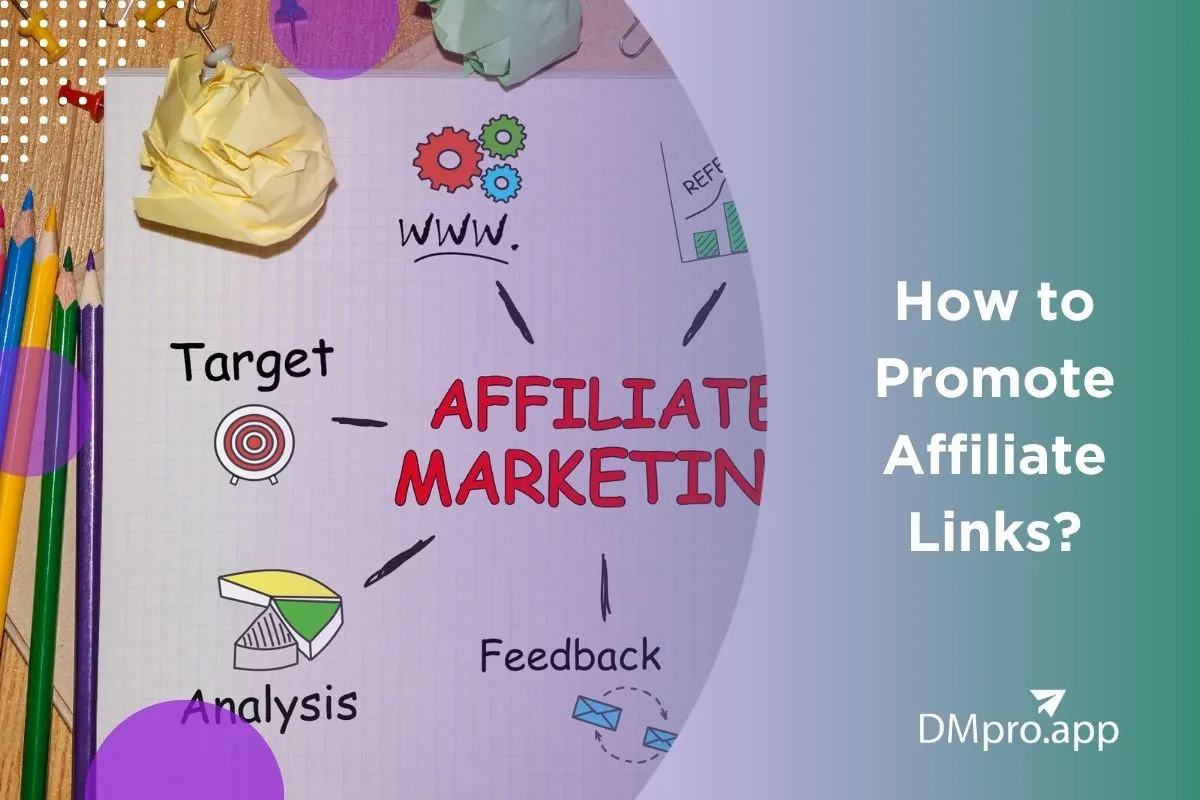Do you want to earn money online without creating your own product? Well, you can promote other companies’ products or services through affiliate links and earn commission for each sale made through your link. But the big question is: how to promote affiliate links?
There are various affiliate programs for creators, so finding the one that matches your needs isn’t hard. However, joining an affiliate program won’t magically make you money. If you really want to earn big, you need to know how to promote your affiliate links the right way.
In this article, we’ll provide all the best ways to promote affiliate links to help you turn the clicks into cash. Ready? Let’s dive in!
TL;DR:
Choose affiliate programs and products that match your audience, then promote your links smartly through relevant channels, create genuinely helpful content, track what’s working, and optimise continuously to boost clicks and conversions.
Table of Contents
Toggle8 Best Ways to Promote Affiliate Links
There’s no single best way to promote affiliate links; the smart tactic is to mix a few easy strategies.
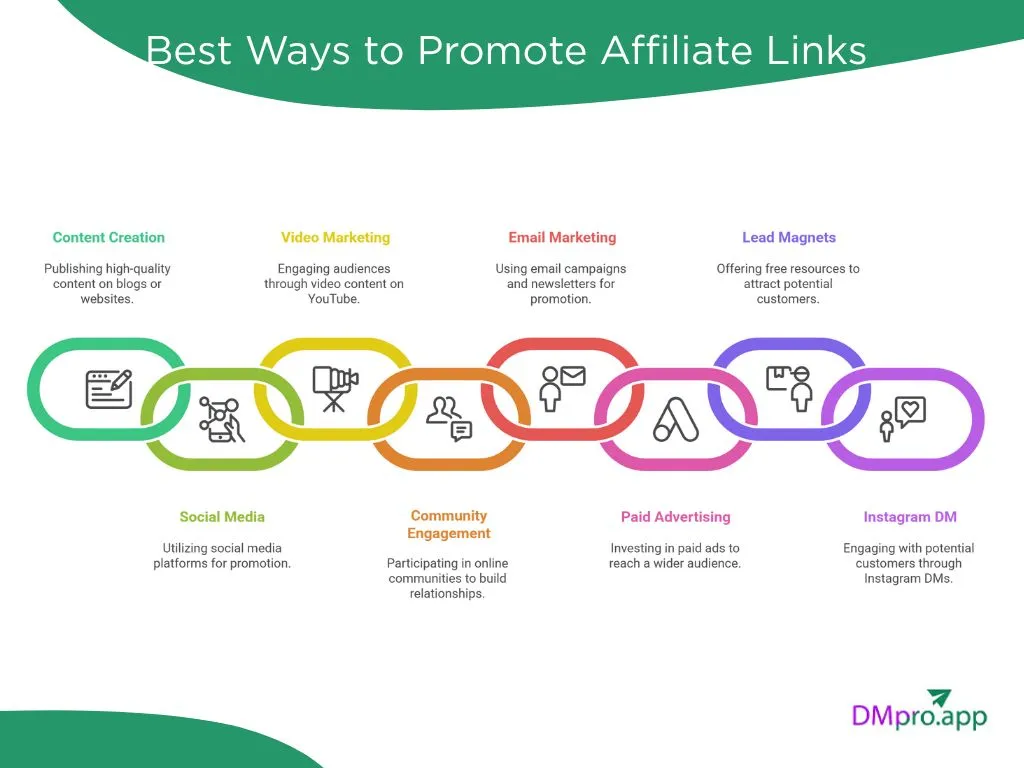
You must pick the ones that work best for your niche and audience.
#1 Publish High-Quality Content on Blogs or Websites
One of the best ways to promote your affiliate links is by creating helpful, valuable content on your website or blog. Instead of pushing products directly, you give people useful information and they’re more likely to trust and click your links. Here are a few smart ways to do it:
- Write Product Reviews: Share your honest opinion about a product, its pros and cons, and your personal experience. Add your affiliate link naturally so readers can check it out.
- Create How-To Guides & Tutorials: Show people step by step how to use a product or service. This builds trust and gives them a clear reason to click your link.
- Publish Listicle Posts: Make fun, easy-to-read lists like “Top 5 Tools I Use Every Day” and link each product. Listicles are great for getting more clicks.
- Write Comparison Posts: Compare two or more products and help your audience choose the best one. These posts often get good search traffic.
- Share Tips & Resource Pages: Create a dedicated page listing your favorite tools or products with affiliate links. This can bring consistent traffic over time.
Note: If you don’t have your own site yet, start on free platforms like Medium or LinkedIn to build traffic and trust around your affiliate links.
You may still wonder: where to promote affiliate links on blog? Well, here’s an example of adding affiliate link in a blog post. First, it lists the top skincare products along with their buying links.
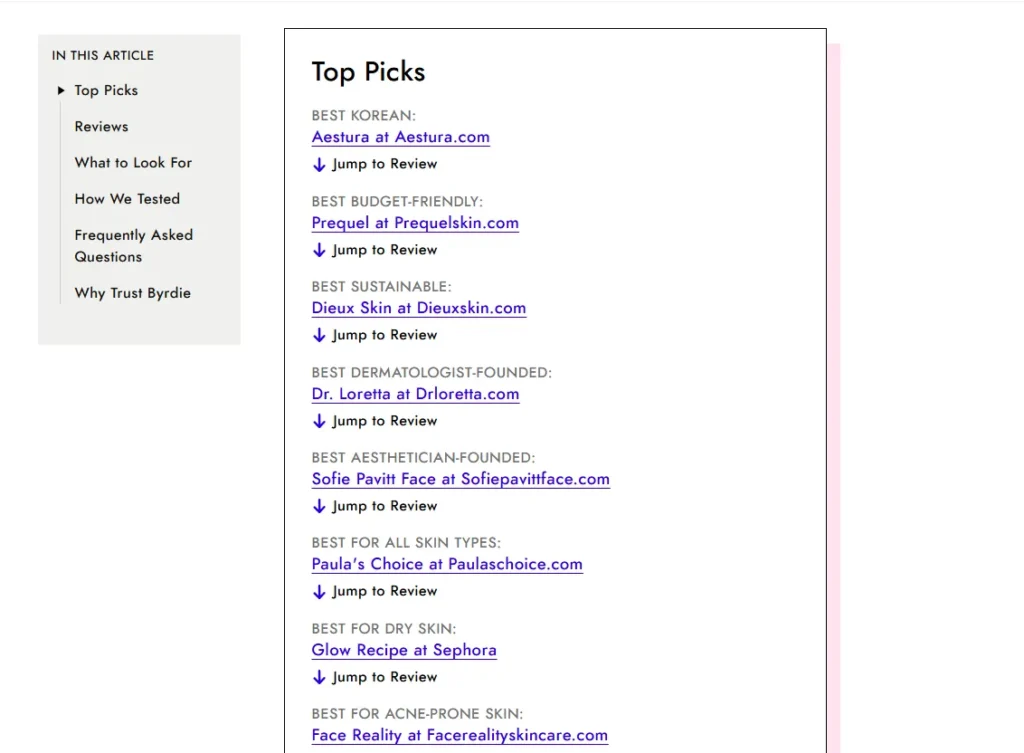
Then, it gives a full review of each product, shows before-and-after videos, explains all the ingredients, and mentions the buying link again at the end.
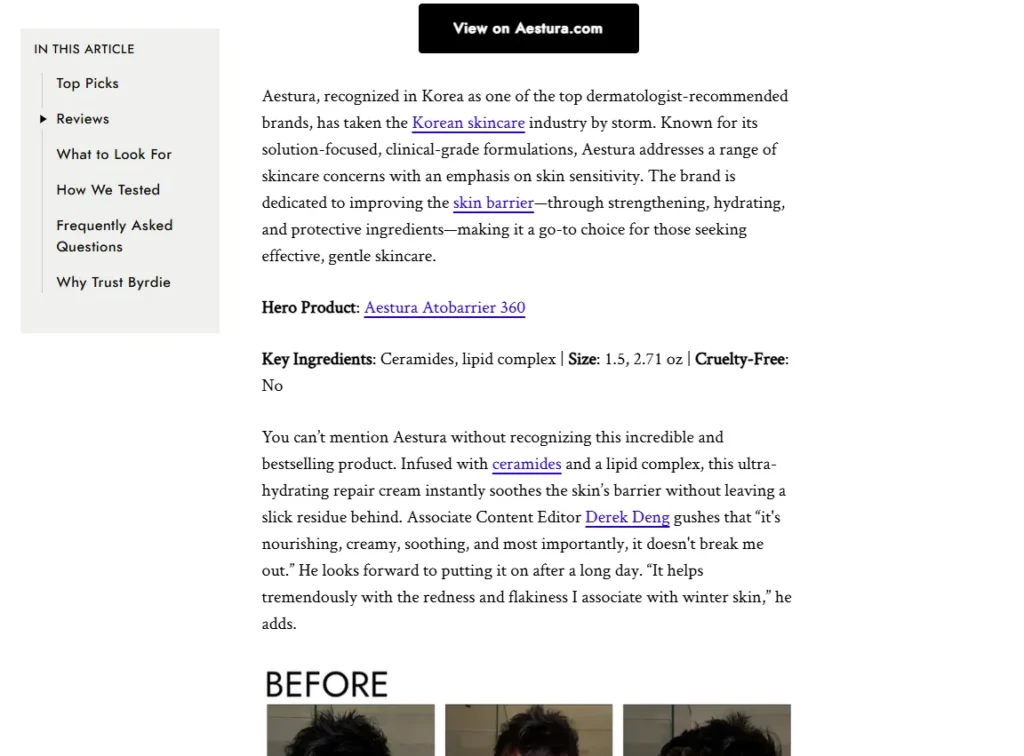
#2 Use Social Media Platforms
You can promote affiliate links and generate leads on social media fast. It’s free (most of the time), everyone’s already hanging out there, and it enables you to talk directly to your audience in a natural way. All you really need to do is share engaging content, add your link in the right spot, and then: that’s traffic coming your way.
This is an example of an Instagram post that shares an affiliate link in bio:
Here are some platform-specific tips to promote affiliate links on social media:
- On Facebook, share your link in posts or groups with a quick story or tip.
- On Instagram, use Reels, Stories, or the link in bio to drive clicks.
- On TikTok, You can show a product in action, share a quick tip, or create a funny/skit-style clip that naturally features the item. Then, you sould drop your affiliate link in your bio so viewers can easily find where to buy.
- On Twitter (X), keep it short and casual. You must share your honest opinion or a quick tip about the product. You can pin your best tweet with the affiliate link to make sure it stays visible to anyone visiting your profile..
- On Pinterest, post cute pins that keep bringing traffic over time.
- On LinkedIn, share helpful tips or experiences with your link naturally.
#3 Video Marketing on YouTube
If you already have a YouTube channel, you can use it to promote affiliate links effectively. You can talk about a product, show how it works, or review it, then drop your affiliate link in the video description or pinned comment. Tutorials, product reviews, and “Top 5” lists work really well.
Just remember to tell viewers where the link is and add a short disclaimer.
Once your videos start getting views, they can keep bringing in traffic and commissions for a long time, even while you sleep. Pretty straightforward!
#4 Engage in Online Communities (Forums, Reddit,…)
You can also promote affiliate links by joining online communities where people are already asking questions and looking for solutions.
Places like Reddit, Quora, niche forums, Q&A sites and Discord can work really well if you’re helpful first and share links. For example, you can answer someone’s question, then mention your blog or video that includes the affiliate link.
Let’s be honest! You must follow community rules and make your links part of a useful answer. This way, people trust you more and are more likely to click.
This is an example of promoting affiliate links on Quora:
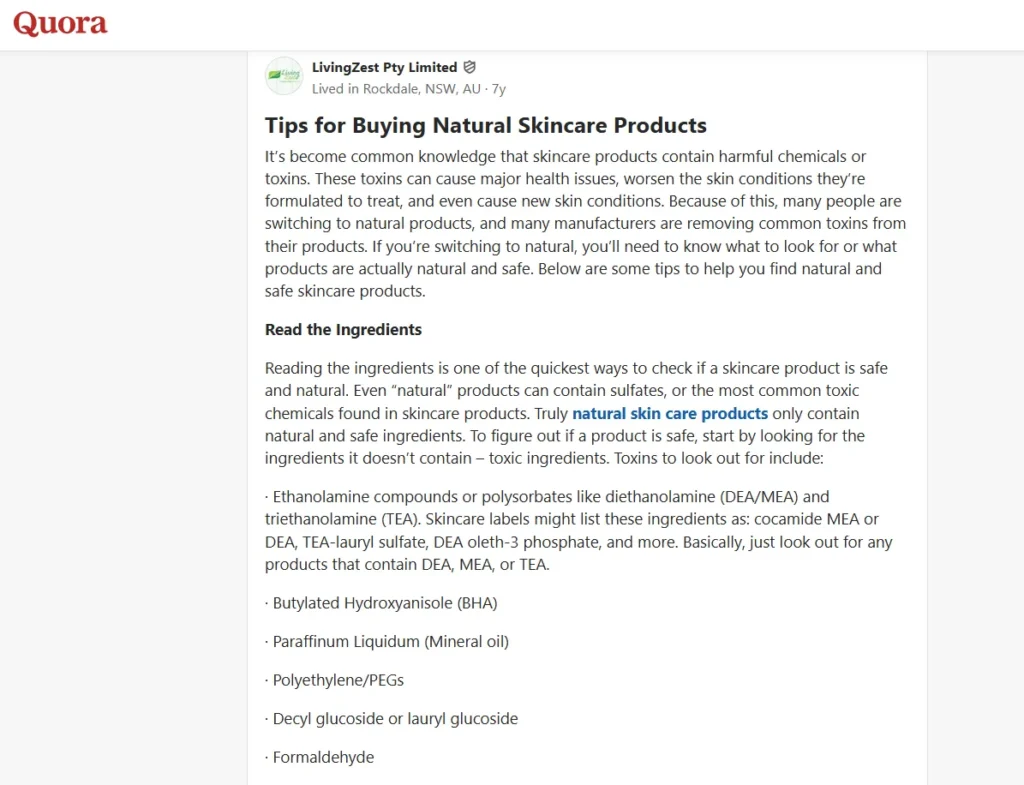
#5 Use Email Marketing and Newsletters
Email marketing is still one of the best ways to make money with affiliate marketing. When someone joins your email list, you get a direct way to talk to them and share your favorite products in a more personal way.
How to Promote Affiliate Links through Email?
Here are some tips that can help you promote affiliate links through Email:
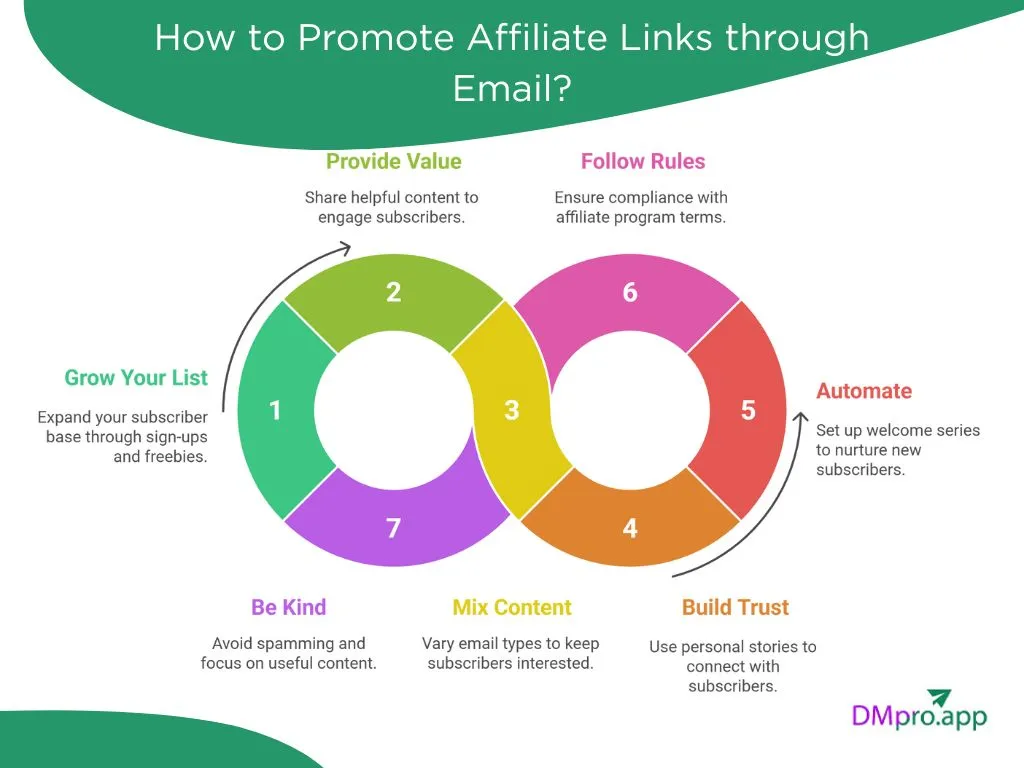
- Grow your list: You can add a sign-up form on your blog or offer a freebie to get people to subscribe.
- Give real value: Don’t make every email a sales pitch. You must share tips, stories, or helpful content and add affiliate links naturally.
- Mix it up: You can send product reviews, deal roundups, or add links inside your regular content emails.
- Build trust: You must write like you’re talking to a friend. Personal stories make your emails feel real, not pushy.
- Automate: Then you should set up a welcome series to warm people up before sharing any offers.
- Follow the rules: Some programs don’t allow links in emails, so check their terms. If needed, link to your website instead.
- Be kind to your list: Don’t spam. You must send useful things, not just promos.
#6 Invest in Paid Ads (PPC, Social Ads)
If you’ve ever asked, “How do I get traffic to my affiliate link?”, one of the fastest ways is through paid ads. With a small budget, you can scale your promotions and reach a targeted audience. It’s best to send traffic to a landing page you control (with your affiliate link) instead of linking directly, since many affiliate programs restrict direct linking.
Here are some ad platforms and the types of content you can use on each:
- Google Ads / Bing Ads:You can use search ads (Google/Bing) alongside social media audience targeting to reach people actively looking for your product.
- Facebook & Instagram Ads: Social advertising like Facebook Ads let you reach specific audiences by interests, location, or behavior.
- YouTube Ads: YouTube ads work if you create short, engaging videos that solve a problem and point viewers to your landing page.
- Pinterest Ads: Image or video pins that highlight your product visually and drive clicks.
- Native Ads (Taboola, Outbrain): Native advertising (like Taboola or Outbrain) can drive traffic through articles or reviews.
#7 Create and Offer Lead Magnets or Free Resources
A great way to get people interested in what you promote is to give them something valuable for free. This could be an ebook, checklist, template, mini-course, webinar, or even a free trial. The idea is to offer something useful first, then guide them toward your affiliate links, both are inside the free resource or through follow-up emails.
Lead magnets do two things:
- They attract people already interested in your topic,
- And they give you a chance to introduce affiliate products naturally.
For example, fitness influencers can share daily free tips or exercises and promote the products they use during each workout via their affiliate links.
Moreover, you can offer something like a “7-Day Fitness Challenge” via email. Each day, share tips and casually mention products you recommend with your affiliate links. People in these courses are already engaged, making them warm leads.
#8 DM Marketing
You reach out to followers, potential customers, or people engaging with your content through DM marketing. This tactic works well because it feels more personal and conversational.
Here’s a guide on how to promote affiliate links for free via DM marketing:
- Respond to Engagement: If someone comments on your post or story asking for advice or showing interest in a product, send a friendly DM with your recommendation and your affiliate link.
- Share Exclusive Tips or Offers: Offer value first, like a quick tip, free resource, or discount, then naturally include your affiliate link.
- Build Relationships: Focus on connecting with your audience rather than just selling. People are more likely to click your link if they trust you.
Best Practices for Promoting Affiliate Links
Before we jump into the tips, remember that affiliate marketing is more than just sharing links. The key is to help your audience, build trust, and recommend products that actually make their lives better. When your links feel helpful, people are more likely to click and buy.
Let’s explore some tips for promoting affiliate links:
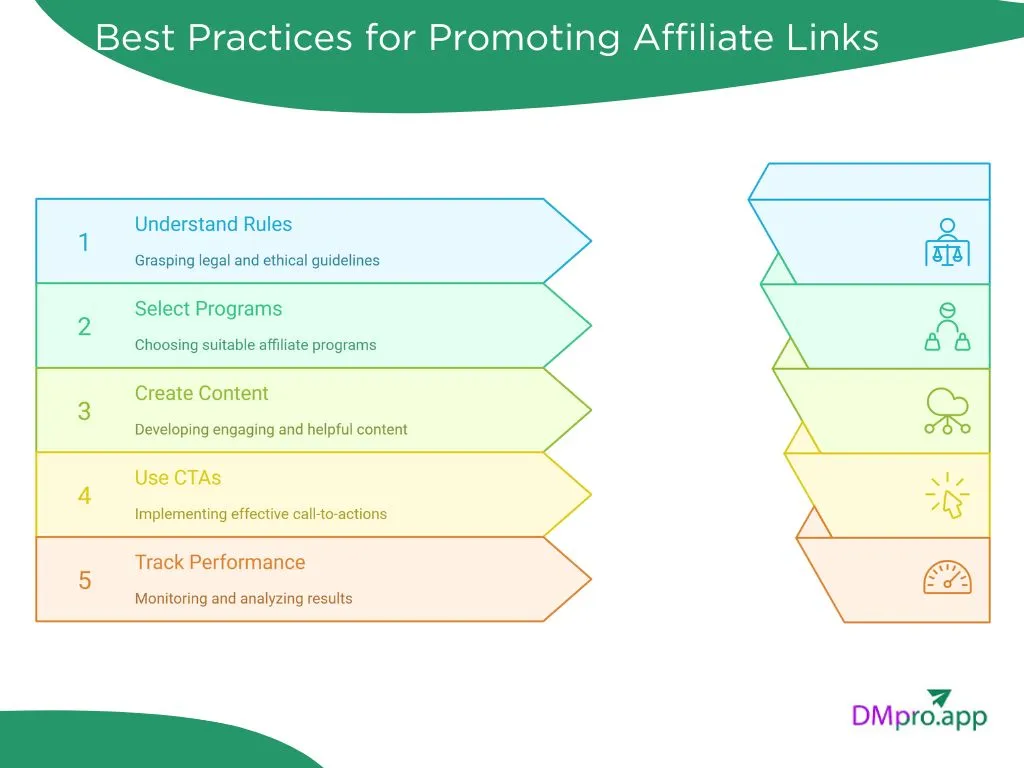
#1 Know the Rules
Every program, including the Amazon affiliate program, has rules. Read them so you don’t lose commissions. For example, some of them don’t allow links in emails or PDFs, or limit ads and brand name use. You must always tell people when a link is an affiliate one, follow privacy laws, and mark links with rel=”nofollow” or rel=”sponsored” for Google.
#2 Pick Programs Carefully
Not all programs are the same. As a creator, pick a program that:
- Relevant to your niche so your audience will like it. For instance, beauty influencers will likely find greater success with beauty affiliate programs compared to promoting unrelated products like gadgets.
- Has good commissions,
- Has longer cookie times,
- With reliable tracking.
- Moreover, you should work with trusted brands and programs that offer support or resources.
#3 Create Helpful, Engaging Content
Share personal stories, comparisons, or case studies instead of just “Buy this.” Make your content easy to read with headings and short paragraphs. Add links naturally in text or images rather than flashy banners. Help your audience decide without overwhelming them.
#4 Use Call-to-Actions Smartly
Tell people what to do next. Simple CTAs like “Learn more,” “Get a free trial,” or “Check price” work very well. Moreover, test different wording to see what works.
#5 Track Performance and Optimize
You must check what’s working with analytics. Then, track clicks and sales using unique IDs or tools like PrettyLinks. Moreover, you need to test headlines, images, link placement, and emails. Stay updated on trends, platform changes, and new programs.
#6 Avoid Common Mistakes
Don’t spam or exaggerate your claims. Don’t forget mobile users. Don’t get discouraged if results are slow. Always disclose links and add disclaimers if needed.
Wrapping Things Up
This guide has provided a complete guide on how to promote affiliate links through proven tactics. We’ve covered all the key ways to share your affiliate links and grow your income. But, the best results come from helping your audience, being honest, and sharing products you believe in.
Additionally, if you want to gain money by selling Amazon products, you can use Amazon affiliate marketing tools to find the best programs related to your niche.
FAQs
You can share your affiliate links on own blog or website (through SEO-driven posts, reviews, etc.), social media platforms like Instagram, Facebook, TikTok, Twitter, and Pinterest, YouTube videos (with links in descriptions), and online communities such as Reddit, Quora, or niche forums.
You must focus on quality over quantity. You should add affiliate links only when they fit naturally and add value. If you’re writing a blog post, link the product the first time you mention it, maybe again in a “where to buy” section, and add a button or banner at the end.

